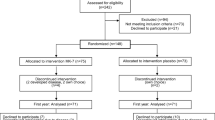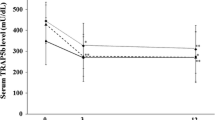Abstract
Ipriflavone (IP) (7-isopropoxyisoflavone), a synthetic isoflavone derivative, is active in both inhibiting bone resorption and enhancing osteoblast function. This property suggested its clinical use in the treatment of involutional osteoporosis, and in the prevention of postmenopausal bone mass loss. Forty postmenopausal women with low bone mineral content were enrolled and randomly treated for 12 months with IP 600 mg/day or placebo (PL), according to a double-blind, parallel group design. All patients wee also given an oral calcium supplementation (1 g/day). Bone mineral density (BMD) was measured at the spine (L2−L4) by dual-energy X-ray absorptiometry. Bone metabolism markers (serum calcium, phosphate, osteocalcin, and alkaline phosphatase, and urinary calcium, phosphate, and hydroxyproline) were assessed at the same times. After 12 months, a reduction of BMD was evidenced in the PL-treated group, at both the spine (−2.2%, P<0.01 vs baseline) and the forearm (−1.2%). In the IP-treated group, an increase of BMD was obtained (+1.2%, P<0.01 vs placebo, at the spine; +3%, not significant, at the forearm). Bone markers were in the normal range for postmenopausal women; no statistically significant modificantions were observed during the treatment period. Three patients were withdrawn from the treatment in the IP-treated group, and two in the PL-treated group for gastrointestinal disturbances. In the other women, the tolerance of the drug was good and the complicance with the oral treatment was excellent.
Similar content being viewed by others
References
Brandi ML (1992) Flavonoids: biochemical effects and therapeutic applications. BaM 19(suppl):s3–s14
Tsuda M, Kitazaki I, Ito T, Fujita T (1986) The effect of ipriflavone (TC-80) on bone resorption in tissue culture. J Bone Miner Res 1:207–211
Yamazaki I, Shino A, Shimizu Y, Tsukuda R, Shirakawa Y, Kinoshita M (1986) Effect of ipriflavone on glucocorticoid-induced osteoporosis in rats. Life Sci 38:951–958
Suda A (1987) Effect of parathyroid hormone on parietal bones of rats, and effect of ipriflavone. J Bone Miner Metab 5:37–42
Bonucci E, Ballanti P, Martelli A, Mereto E, Brambilla G, Bianco P, Bufalino L (1991) Ipriflavone inhibits osteoclast differentiation in parathyroid transplanted parietal bone of rats. Calcif Tissue Int 50:314–319
Bonucci E, Silvestrini G, Ballanti P, Masi L, Franchi A, Bufalino L, Brandi ML (1992) Cytological and ultrastructural investigation on osteoblastic and preosteoclastic cells grown in vitro in the presence of ipriflavone: preliminary results. BaM 19(suppl 1):s15–s25
Morita I, Sakaguchi K, Kurachi T, Murota SI (1992) Ipriflavone inhibits murine osteoclast formation in vitro. Calcif Tissue Int 51(suppl):s7–S10
Notoya K, Yoshida K, Taketomi S, Yamazaki I, Kumegawa M (1992) Inhibitory effect of ipriflavone on pit formation in mouse unfractionated bone cells. Calcif Tissue Int 51(suppl):s3–s6
Benvenuti S, Tanini A, Frediani U, Masi L, Casano R, Bufalino L, Serio M, Brandi ML (1991) Effects of iprifavone and its metabolites on a clonal osteoblastic cell line. J Bone Miner Res 6:987–996
Notoya K, Tsukuda R, Yoshida K, Taketomi S (1992) Stimulatory effect of ipriflavone on formation of bone-like tissue in rat bone marrow stromal cell culture. Calcif Tissue Int 51(suppl)Ss16–s20
Yamazaki I, Shino A, Tsukuda R (1986) Effect of ipriflavone on osteoporosis induced by ovariectomy. J Jpn Soc Bone Miner Metab 3:205–210
Yamazaki I (1986) Effect of ipriflavone on the response of uterus and thyroid to estrogens. Life Sci 38:757–764
Aoki N, Imamura M (1986) Clinical efficacy and effects of ipriflavone on endocrine function in patients with primary or secondary osteoporosis. Jpn Pharmacol Ther 14:843–849
Melis GB, Paoletti AM, Cagnacci A, Bufalino L, Spinetti A, Gambacciani M, Fioretti P (in press) Lack of any estrogenic effect of ipriflavone in postmenopausal wome. J Endocrinol Invest
Sugioka I, Iguchi M, Ishizaki T, Ihara H (1986) Effectiveness and safety of TC-80 in long-term administration in patients with osteoporosis. Jpn J Clin Exp Med 63:1295
Matsunaga T, Osuneda M, Nojiri M, Akaboshi Y (1985) Clinical evaluation of ipriflavone in patients with osteoporosis. Jpn Pharmacol Ther 13:7389–7393
Orimo H (1990) Effect of ipriflavone in involutional osteoporosis. In: Christiansen C, Overgaard K (eds) Proc 3rd Int Symp Osteoporosis, Copenhagen, October 14–18. Osteopress ApS 3: 2156–2158
Bossanyi A (1990) Long-term tolerance of the drug and efficacy of ipriflavone in the treatment of osteoporosis. In: Christiansen C, Overgaard K (eds) Proc 3rd Int Symp Osteoporosis. Copenhagen, October 14–18. Osteopress ApS 3:2168–2173
Agnusdei D, Zacchei F, Bigazzi S, Cepollaro C, Nardi P, Montaganani M, Gennari C (1989) Metabolic and clinical effects of ipriflavone in established post-menopausal osteoporosis. Drugs Expl Clin Res XV(2):97–104
Agnusdei D, Camporeale A, Zacchei F, et al. (1992) Effects of ipriflavone on bone mass and bone remodeling in patients with established postmenopausal osteoporosis. Curr Ther Res 51:82–91
Isaia GC (1991) L'ipriflavone nel trattamento dell'osteoporosi postmenopausale. Studio multicentrico italiano (abstract). Minerva Endocrinol 16(suppl 1, no 3):77
Agnusdei D, Adami S, Cervetti R, Crepaldi G, Di Munno O, Fantasia L, Isaia GC, Letizia G, Ortolani S, Passeri M, Serni U, Vecchiet L, Gennari C (1992) Effects of ipriflavone on bone mass and calcium metabolism in postmenopausal osteoporosis. BaM 19(suppl):s43–s48
Passeri M, Biondi M, Costi D, Bufalino L, Castiglione GN, Di Peppe C, Abate G (1992) Effects of ipriflavone on bone mass in elderly osteoporotic women. BaM 19(suppl):s57–s62
Agnusdei D, Camporeale A, Gonnelli S, Gennari C, Baroni MC, Passeri M (1992) Short-term treatment of Paget's disease of bone with ipriflavone. BaM 19(suppl):s35–s42
Mazzuoli G, Romagnoli E, Carnevale V, Scarda A, Scarnecchia L, Pacitti MT, Rosso R, Minisola S (1992) Effects of ipriflavone on bone remodeling in primary hyperparathyroidism. BaM 19(suppl)s27–s33
Fujita T, Ono K, Inoue T, Torizuka K, Shimazu A (1985) Dosefinding study on TC-80 (ipriflavone) in osteoporosis. Prog Med 5:2959–2963
Fourtillan JB, Decourt JP, Girault J, Istin B, Faye B, Renaud Y, Canet W, Ingraud I (1990) Comparative bioavailability of ipriflavone and its metabolites in young and healthy volunteers, at steady-state, when given on multiple dosing, and during 10 days as two treatments (one 200 mg tablet t.i.d., and one 300 mg capsule b.i.d.). CEMAF s.a. Institute, Poitiers, France. Report n. AD89OH, December 28th, 1990 (Internal Report)
Author information
Authors and Affiliations
Rights and permissions
About this article
Cite this article
Valente, M., Bufalino, L., Castiglione, G.N. et al. Effects of 1-year treatment with ipriflavone on bone in postmenopausal women with low bone mass. Calcif Tissue Int 54, 377–380 (1994). https://doi.org/10.1007/BF00305522
Received:
Accepted:
Issue Date:
DOI: https://doi.org/10.1007/BF00305522




